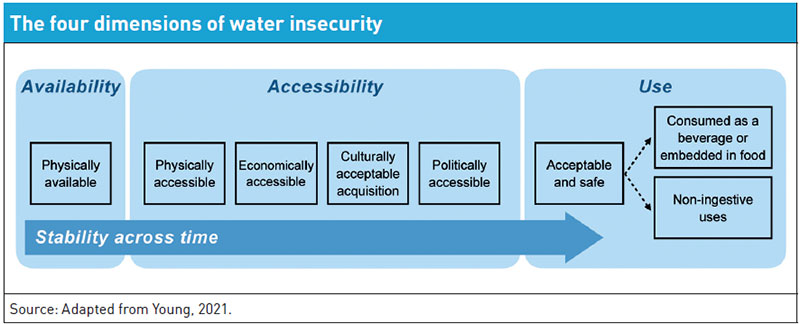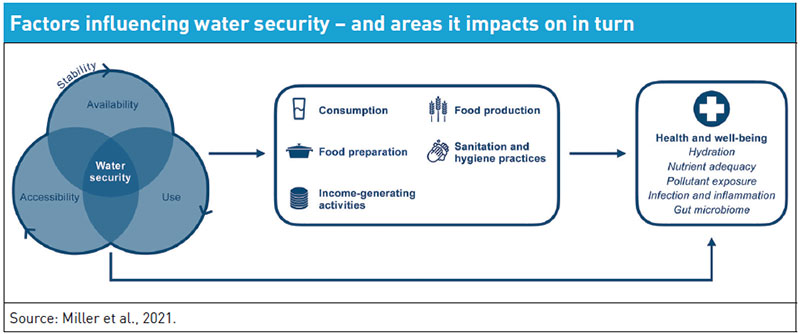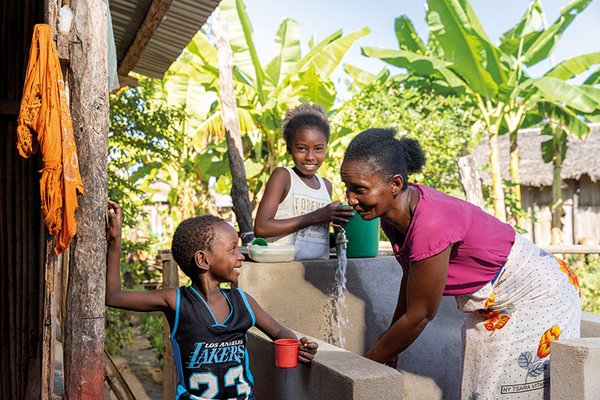 Download this article in magazine layout
Download this article in magazine layout
- Share this article
- Subscribe to our newsletter
Measuring human experiences with water to inform policy and practice
Water is life. It is a critical nutrient and a necessary resource for growing crops, raising livestock, cleaning and preparing foods, and for implementing hygienic practices that limit exposure to disease-causing pathogens and chemicals. Despite its importance, our understanding of who lacks access to safe water and how such limitations impact health and development is insufficient. Until recently, most assessments have focused on identifying which water sources households primarily use for drinking. While this information is helpful for determining potential pathogenic exposure, it does not provide insight into whether available water sources are accessible, affordable, culturally and socially acceptable, or sufficient for all household uses, from drinking to cleaning and cooking. Consideration of the human experience has the potential to address this knowledge gap and provide a more holistic understanding of the global water crisis.

Drawing on experience with predicting food insecurity
The utility of experiential indicators has a historical precedent. Throughout the 20th century, food insecurity was almost exclusively conceptualised in terms of food production and availability. The number of calories available per capita, calculated using food balance sheets, was a primary nutrition indicator. But such national-level measures masked inequities at sub-national levels. Further, these measures poorly predicted food insecurity risk in many settings, with malnutrition persisting in regions with high food availability.
Near the turn of the century, experiential food insecurity measures were developed to provide a more complete picture of the global food crisis. These experienced-based tools, which capture dimensions of food access, quality and use, have received widespread recognition and helped demonstrate that food insecurity is a prevalent issue. The tools have also been used to identify at-risk groups and inform the creation of more effective strategies for reducing the burden of malnutrition. In fact, progress toward Sustainable Development Goal 2 – zero hunger – is tracked using experiential food insecurity data.
The water sector is undergoing a similar change. Most international agencies, researchers and public health practitioners currently measure drinking water service availability by counting the number of users connected to a piped network or estimating the proportion of the population that relies on open-water sources like lakes and rivers, which have a high risk of contamination. Findings generated from this work have expanded our understanding of the global water landscape, but other key dimensions of water security that can be targeted to improve livelihoods, health and well-being have historically been overlooked.
In 2017, a team of over 40 researchers developed the Water Insecurity Experiences (WISE) Scales to concurrently capture all salient aspects of water insecurity, or the inability to reliably access safe water for all domestic uses. The household- and individual-level tools take fewer than three minutes to implement and provide a human voice to water insecurity. Participants are asked to report how frequently they experienced twelve water-related issues, ranging from worrying about not having enough water to going to sleep thirsty, in either the prior four weeks or one year. Resultant scores can be examined in their continuous form or dichotomised to compare differences between those who are experiencing substantial water insecurity relative to those who are not.

The burden of water insecurity is not borne equally
The WISE Scales have been used by hundreds of academics, development organisations, governmental agencies and public health advocates. Additionally, the Individual WISE Scale has been included in the 2020 and 2022 rounds of the Gallup World Poll – which tracks important issues such as food access and employment world-wide, generating the first nationally representative estimates of water insecurity. The prevalence of water insecurity differed substantially across sampled countries, from 3.6 per cent in China to 63.9 per cent in Cameroon. Across assessed regions, prevalence of water insecurity was highest in sub-Saharan Africa (36.1 %) and lowest in Asia (9.1 %). Among the full sample, an estimated 14.2 per cent, or approximately 436 million of the 3.06 billion adults represented by this sample, were classified as water insecure. This prevalence was heavily influenced by China's low water insecurity prevalence and large population. Based on these data, individuals who struggled to get by on their incomes were predicted to have greater water insecurity experiences than their more financially secure peers. Additionally, water-insecure individuals were two to three times more likely to be food insecure, even after controlling for many known confounders, including gender, age and income.
Application of the tool in smaller projects has also demonstrated that water insecurity negatively impacts health and well-being. To date, studies have found that greater water insecurity is associated with greater food insecurity, lower dietary diversity, greater mental distress and higher risk of communicable disease, including higher HIV viral loads. This suggests that addressing water insecurity has the potential to meaningfully improve public health issues of international significance.
Actionable insights for aid and development agencies
The WISE Scales can help identify vulnerable populations and more effectively target resources to those who need them most. They can also be used to measure the impact of programmatic efforts, such as borehole construction, as well as natural shocks, including floods and droughts. The Swiss development organisation Helvetas is currently piloting the use of the Household Water Insecurity Experience (HWISE) Scale in Karnali Province in Nepal, where it has accompanied water infrastructure improvement projects for nearly 50 years, to understand people’s experiences before and after water service interventions. In a 2021 survey, 18 per cent of respondents were water insecure, as measured using the HWISE Scale. That same year, with the support of the not-for-profit charity: water, Helvetas partnered with local actors to install household water connections in over 5,500 households. In the follow-up survey in 2022, less than three per cent of respondents were water insecure.
The initial results show a significant decrease in people’s experiences of water insecurity after receiving household connections. In particular, there was a marked decrease in reports of feeling angry about the water service, feeling worried about not having enough water, and experiencing interruptions or a limited water supply. The HWISE Scale is also being piloted as part of a baseline survey of 8,400 households in 50 villages in Madagascar that will be connected to water service through charity: water’s support.
Adapting the scales for schools and health centres
Although implementation of the scales is widespread, they were not designed for use in settings beyond the household. Helvetas is therefore collaborating with the Swiss Water and Sanitation Consortium and Northwestern University, in the USA, to develop a new set of scales for use in evaluating experiences with water, sanitation, and hygiene services of those working in and receiving services from schools and health care facilities. By giving a human voice to water insecurity through the measurement of user experiences, we will be better equipped to advocate for change and advance toward a water-secure world for all.
Joshua D. Miller is a doctoral student in the Department of Nutrition at the University of North Carolina at Chapel Hill, USA.
Sera L. Young is an Associate Professor in the Department of Anthropology at Northwestern University, Illinois, USA.
John Brogan is a WASH Advisor at Helvetas and is based in Zurich, Switzerland.
Contact: josh.miller(at)unc.edu





Add a comment
Be the First to Comment